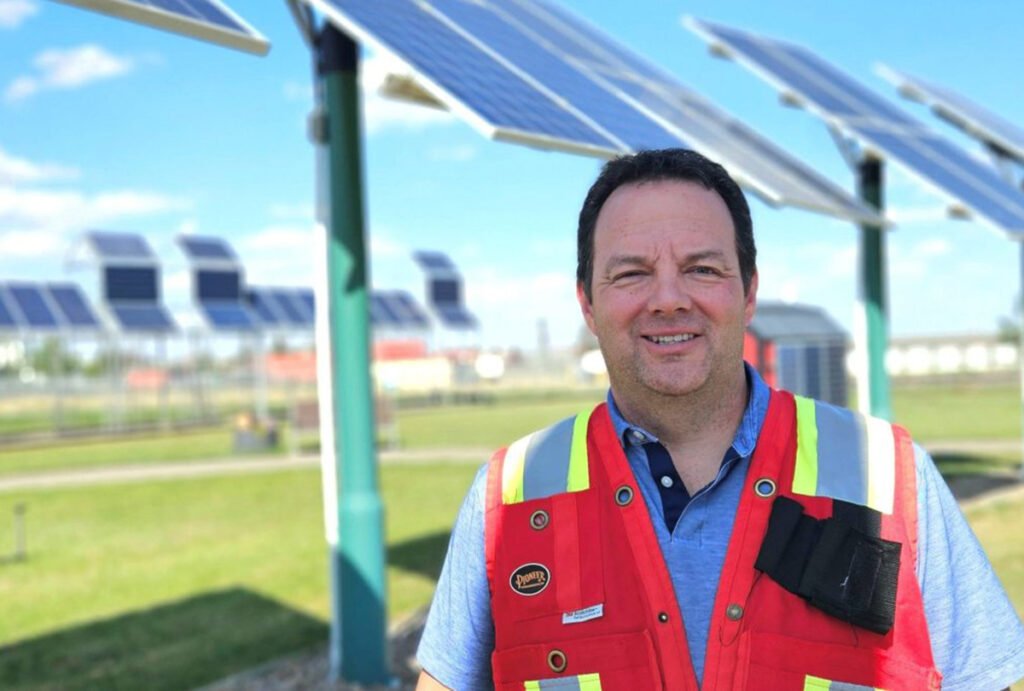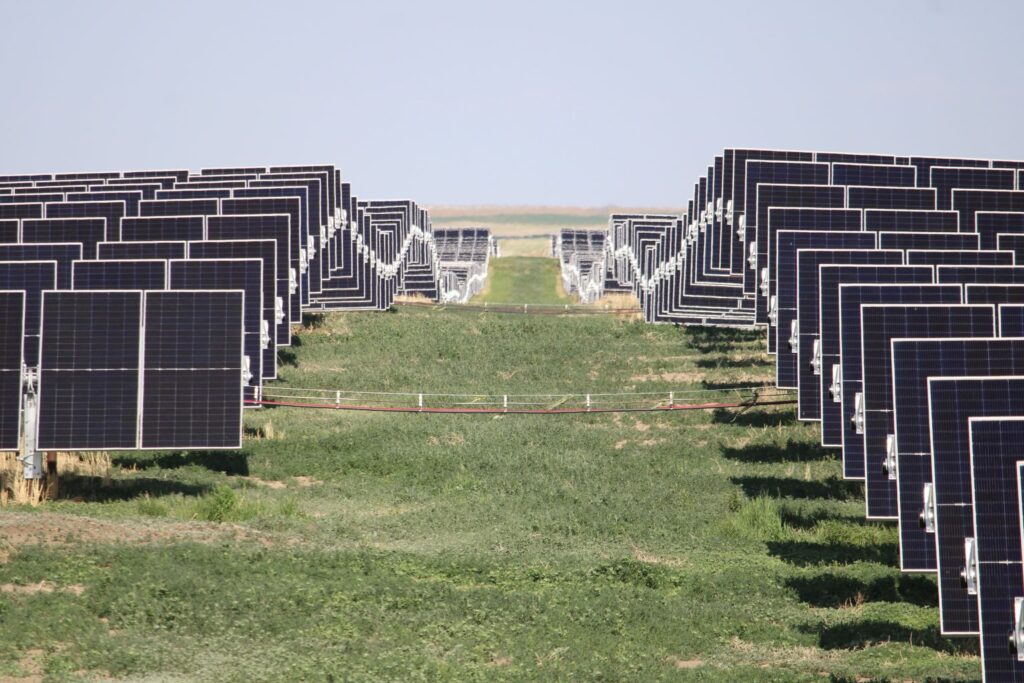Alberta leads charge for renewables with deregulated electricity market and sunny weather
By James Snell
Follow CEC on Linkedin CEC Linkedin
Follow CEC on Facebook CEC Facebook
Follow CEC on Twitter CEC Twitter

Nels Petersen, chief administrative officer of Vulcan County, at the Vulcan Solar Park in 2023. Photo by James Snell for the Canadian Energy Centre
Vulcan County in southern Alberta, known for its ubiquitous Star Trek displays in the town of Vulcan, now has another claim to fame – the largest solar power facility in Canada.
The $700 million Travers Solar Project, owned by an Axium Infrastructure managed fund, looks like a scene from the venerated science fiction series – 3,330-acres of glass, steel and electronic gadgetry. “High Voltage” warning signs hang from perimeter security fences.
Located 130 kilometres southeast of Calgary, Travers has capacity to produce up to 465 megawatts (MW) – enough electricity to power over 150,000 homes under optimal conditions. The operation, which came online in 2022, could offset around 624,000 tonnes of emissions each year. The project has a 15-year power purchase agreement with online retailer Amazon for 400 MW – representing 86 per cent of capacity.
“One of the nice things with these renewables that have come to the county as of late is they make up for a shortfall in our [tax] assessment,” says Nels Petersen, chief administrative officer of Vulcan County.
The 1.3 million-panel project will generate around $3 million per year in taxes for the county, he says –needed money to help maintain the county’s 1,800 miles of gravel roads and other infrastructure.
“As the total assessment base grows, our taxes [on residents] are dropping,” says Petersen.

A section of the Travers Solar Project in southern Alberta. Photo by James Snell for the Canadian Energy Centre
There are three other major renewable energy projects in Vulcan County, which sees around 312 days of sunshine per year: the EDF Renewables and Enbridge Blackspring Ridge Wind Farm, 166 turbines with capacity to produce 300MW; the Buffalo Plains Wind Farm, under construction, 83 turbines with capacity to produce 514MW; and the planned Vulcan GP2 solar farm at 22MW.
In total, renewable energy projects in the county support around 20 long-term jobs. Construction workers are brought in from larger communities when needed.
Many new companies are exploring the possibility of developing more projects in the county, says Jason Schneider, reeve of Vulcan County.
“It’s a good thing,” he says. “You definitely don’t want to turn away development, but there is a point when you say, I don’t know how many more of these we can support.”
One of the concerns is the future reclamation of the projects, Petersen said.
Alberta takes lead in solar
Alberta has taken a commanding lead in the current Canadian solar project pipeline, says Matthew Sahd, a research analyst with Wood Mackenzie Power & Renewables.
“The main driver of Alberta’s rise is the province’s deregulated electricity market, which helps more easily facilitate power purchase agreements from companies looking to reduce their emissions,” he says.
According to the Canadian Renewable Energy Association (CanREA), “Canada has only begun to scratch the surface” of its substantial wind and solar resources. By the end of 2022, there was nearly 15 gigawatts (GW) of operating wind energy capacity and over 4 GW of major solar. Canada has about 150 GW of total installed electricity generation capacity, according to the International Energy Agency.
“I am happy to see that, across Canada, the sector grew by an impressive 10.5 per cent in 2022,” says Phil McKay, CanREA’s senior director of technical and utility affairs. “Canada now has an installed capacity of more than 19 GW of utility-scale wind and solar energy, having added more than 1.8 GW of new generation capacity in 2022.”
Solar power is growing particularly fast, says CanREA – over a quarter of all the installed capacity in Canada was added in 2022. Western Canada is leading the charge, accounting for 98 per cent of total growth, with Alberta adding 1.39 GW and Saskatchewan adding 387 MW of installed capacity in 2022. Quebec contributed 24 MW, while Ontario contributed 10 MW, and Nova Scotia 2 MW.
Mytilineos SA, a Greek company, is kicking off a $1.7-billion project to build five solar power facilities in southern and central Alberta. Once up and running by 2027 they will have capacity to produce 1.4 GW – enough electricity for around 200,000 homes.
“Business conditions in Canada in general are good, and we feel more comfortable there than in the United States,” said CEO Evangelos Mytilineos in an interview with the Globe and Mail.
Renewables are an emerging source of employment, says CanREA – mostly in construction, but also long-term jobs in operations and maintenance. Wind and solar accounted for over 4,400 person-years of employment in 2022, having expanded by 86 per cent from 2,400 in 2021.
“And we are anticipating these employment opportunities to keep expanding exponentially as the renewables industry continues to grow,” says McKay.
Grid-scale energy storage
According to the International Energy Agency (IEA), more investment in energy storage is required around the world to address the challenge of the intermittency of renewable power – solar doesn’t work when the sun isn’t shining.
“The rapid scaling up of energy storage systems will be critical to address the hour‐to‐hour variability of wind and solar electricity generation on the grid, especially as their share of generation increases rapidly,” says the IEA.
Energy storage is the conversion of difficult to store power – like wind and solar – into energy that can be used in the future, says CanREA.
Lithium-ion batteries are currently the most scalable form of grid-scale storage, the IEA said in a 2022 report.
Energy storage increased across Canada by 30.5 per cent, or 50 MW in 2022, says CanREA. Alberta led the way with 40 MW – doubling its energy storage capacity in 2022.
Across the country, as of December 2022, Ontario had the most installed energy storage capacity, with 126 MW, having added 10 MW, while Alberta had 82 MW. British Columbia, Quebec, New Brunswick, Saskatchewan, and Prince Edward Island also have energy storage capacity, says CanREA.
“CanREA is working hard to dramatically accelerate and expand the deployment of wind, solar and energy-storage technologies—there are several policy, regulatory and infrastructure barriers that we think need to be addressed,” says Vittoria Bellissimo, CEO of CanREA.
Challenges with solar
A disadvantage of solar power is the disruption of local ecosystems during and after construction. Solar panels, which have an approximate life cycle of 30 to 35 years, also contain toxic materials.
“The decommissioning of solar facilities, more specifically solar modules, has become an industry concern as the solar market matures in North America,” says Sahd, noting large solar companies like Silicon Ranch – developing a project in Alberta – AES, and Orsted have signed agreements with SolarCycle, a Texas company aiming to recycle panels.
A large volume of discarded solar panels will soon pose a risk of “existentially damaging proportions” says a 2021 Harvard Business Review article – official projections say a large quantity of annual waste is anticipated by the early 2030s and could total 78 million tonnes by 2050.
Share This:






